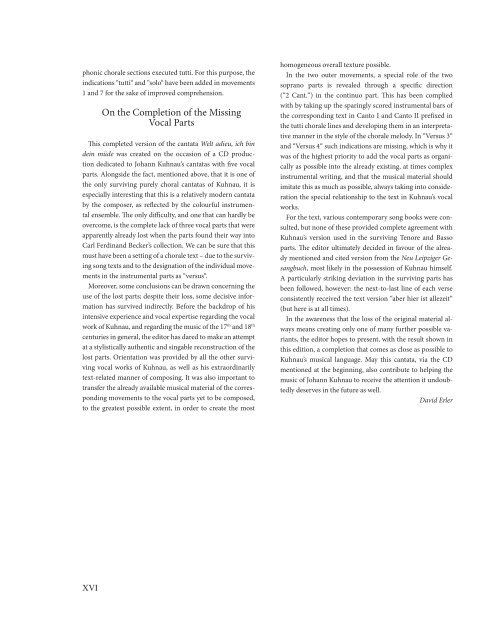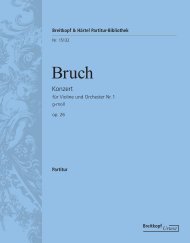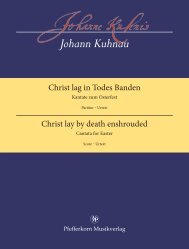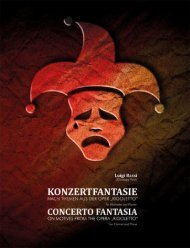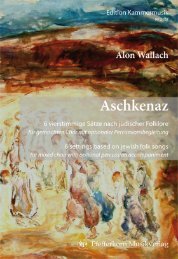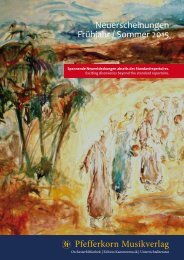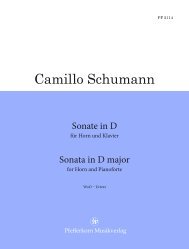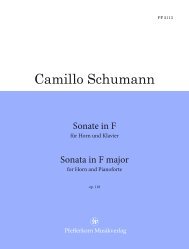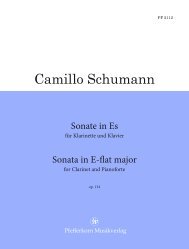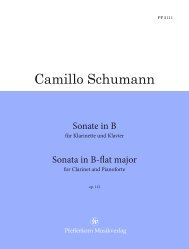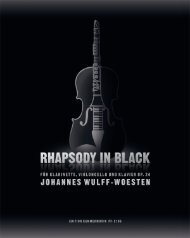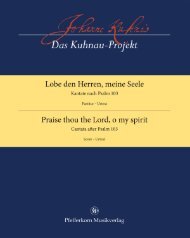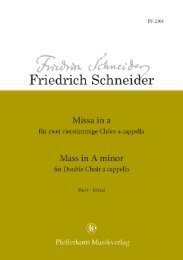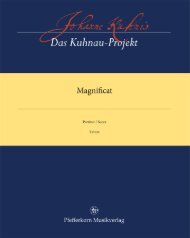PF-2092
Johann Kuhnau Welt adieu, ich bin dein müde / World adieu, I tire of you
Johann Kuhnau Welt adieu, ich bin dein müde / World adieu, I tire of you
Erfolgreiche ePaper selbst erstellen
Machen Sie aus Ihren PDF Publikationen ein blätterbares Flipbook mit unserer einzigartigen Google optimierten e-Paper Software.
phonic chorale sections executed tutti. For this purpose, the<br />
indications “tutti“ and “solo“ have been added in movements<br />
1 and 7 for the sake of improved comprehension.<br />
On the Completion of the Missing<br />
Vocal Parts<br />
This completed version of the cantata Welt adieu, ich bin<br />
dein müde was created on the occasion of a CD production<br />
dedicated to Johann Kuhnau’s cantatas with five vocal<br />
parts. Alongside the fact, mentioned above, that it is one of<br />
the only surviving purely choral cantatas of Kuhnau, it is<br />
especially interesting that this is a relatively modern cantata<br />
by the composer, as reflected by the colourful instrumental<br />
ensemble. The only difficulty, and one that can hardly be<br />
overcome, is the complete lack of three vocal parts that were<br />
apparently already lost when the parts found their way into<br />
Carl Ferdinand Becker’s collection. We can be sure that this<br />
must have been a setting of a chorale text – due to the surviving<br />
song texts and to the designation of the individual movements<br />
in the instrumental parts as “versus“.<br />
Moreover, some conclusions can be drawn concerning the<br />
use of the lost parts; despite their loss, some decisive information<br />
has survived indirectly. Before the backdrop of his<br />
intensive experience and vocal expertise regarding the vocal<br />
work of Kuhnau, and regarding the music of the 17 th and 18 th<br />
centuries in general, the editor has dared to make an attempt<br />
at a stylistically authentic and singable reconstruction of the<br />
lost parts. Orientation was provided by all the other surviving<br />
vocal works of Kuhnau, as well as his extraordinarily<br />
text-related manner of composing. It was also important to<br />
transfer the already available musical material of the corresponding<br />
movements to the vocal parts yet to be composed,<br />
to the greatest possible extent, in order to create the most<br />
homogeneous overall texture possible.<br />
In the two outer movements, a special role of the two<br />
soprano parts is revealed through a specific direction<br />
(“2 Cant.“) in the continuo part. This has been complied<br />
with by taking up the sparingly scored instrumental bars of<br />
the corresponding text in Canto I and Canto II prefixed in<br />
the tutti chorale lines and developing them in an interpretative<br />
manner in the style of the chorale melody. In “Versus 3“<br />
and “Versus 4“ such indications are missing, which is why it<br />
was of the highest priority to add the vocal parts as organically<br />
as possible into the already existing, at times complex<br />
instrumental writing, and that the musical material should<br />
imitate this as much as possible, always taking into consideration<br />
the special relationship to the text in Kuhnau’s vocal<br />
works.<br />
For the text, various contemporary song books were consulted,<br />
but none of these provided complete agreement with<br />
Kuhnau’s version used in the surviving Tenore and Basso<br />
parts. The editor ultimately decided in favour of the already<br />
mentioned and cited version from the Neu Leipziger Gesangbuch,<br />
most likely in the possession of Kuhnau himself.<br />
A particularly striking deviation in the surviving parts has<br />
been followed, however: the next-to-last line of each verse<br />
consistently received the text version “aber hier ist allezeit“<br />
(but here is at all times).<br />
In the awareness that the loss of the original material always<br />
means creating only one of many further possible variants,<br />
the editor hopes to present, with the result shown in<br />
this edition, a completion that comes as close as possible to<br />
Kuhnau’s musical language. May this cantata, via the CD<br />
mentioned at the beginning, also contribute to helping the<br />
music of Johann Kuhnau to receive the attention it undoubtedly<br />
deserves in the future as well.<br />
David Erler<br />
XVI


